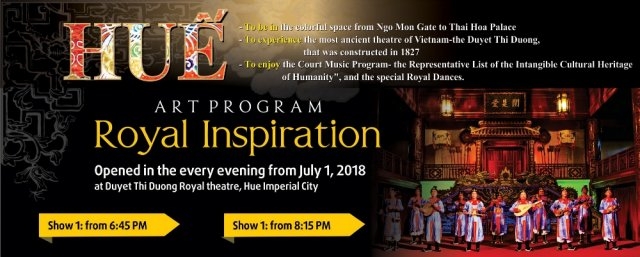[ad_1]
Performances of Nha Nhac (Hue royal court music), a UNESCO intangible heritage, will begin on July 1 at Hue Imperial Citadel in the central city of Hue and then be held every evening thereafter.

The shows are organized by the Hue Monuments Conservation Center to present visitors with the opportunity to learn more about Nha Nhac, which was honored as a “Masterpiece of Oral and Intangible Heritage of Humanity” by UNESCO in 2003. It also adds to the evening entertainment options for tourists.
With the theme “Royal Inspiration”, the show will be performed along the road connecting Ngo Mon (Noon Gate), Thai Hoa Palace, and the ancient Duyet Thi Duong Theater, the country’s oldest theatre and built in 1827, in the UNESCO World Heritage Site of Hue Imperial Citadel.
Visitors can also enter the citadel and explore Vietnam’s former imperial capital and Hue royal court music. Two shows are held, at 6.45 pm and 8.15 pm, with tickets costing VND250,000 ($11).
Nha Nhac, which means “elegant music”, refers to a broad range of musical and dance styles performed at the royal court from the 15th to mid-20th century.
It was generally featured at opening and closing ceremonies associated with anniversaries, religious holidays, coronations, funerals and official receptions.
Among the numerous musical genres that developed in Vietnam, only Nha Nhac can claim a nationwide scope and strong links with the traditions of other East Asian countries.
Performances formerly featured numerous singers, dancers and musicians dressed in sumptuous costumes.
Large-scale orchestras included a prominent drum section and many other types of percussion instruments as well as a variety of wind and string instruments.
Nha Nhac developed during the Le Dynasty (1427-1788) and became highly institutionalized and codified under the Nguyen Dynasty (1802-1945).
As a symbol of the dynasty’s power and longevity, Nha Nhac became an essential part of the court’s many ceremonies.
Certain forms of Nha Nhac have been maintained in popular rituals and religious ceremonies and serve as a source of inspiration for contemporary Vietnamese music.
VN Economic Times
[ad_2]
Source link
